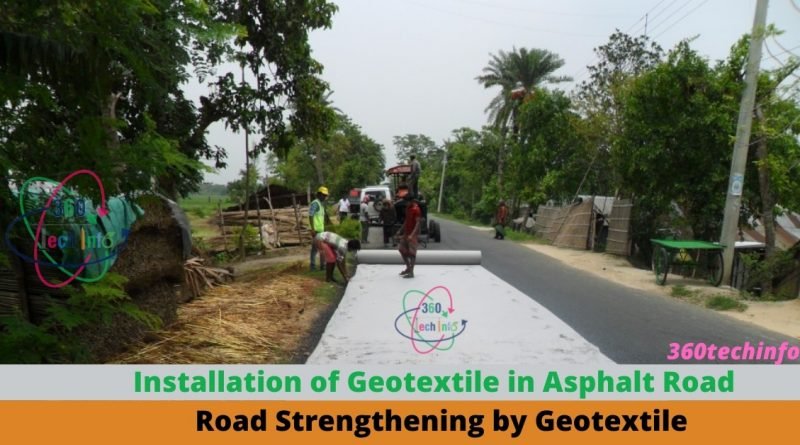Installation of Geotextile in Asphalt Road II Road Strengthening by Geotextile
When selecting geotextiles for road stabilization, some factors should be considered, such as water infiltration, groundwater, canals, and infrastructure beneath the road, and the contraction and expansion of asphalt over time. In this article, we discuss the Installation of Geotextile in Asphalt Road.
A geotextile does not decompose in the soil due to its polymeric composition and is therefore suitable for road construction activities. It can protect, split, filter, reinforce, and discharge, and is therefore used for improving the coating performance and extending the service life of asphalt and roads.
Why Geotextile used in Road Stabilization?
Paving fabric interlayer systems provide a cost-effective means of solving general pavement distress problems. A paving fabric interlayer system complements any paving operation because it is easy to install. It is recommended for use when a pavement begins to exhibit hairline cracks. It is also recommended for use in new pavement construction as a waterproof pavement.
Geotextile has some unique technical properties which provide road more stability and strength.
- Filtration propertise
- Seperation Propertise
- Stengthening or reinforcement propertise.
1. Filtration Propertise
As conventional method sand is provided as a filtration layer for water drainage. All types of geotextiles are not equally effective at filtering water. In order to be effective, the fabric should have many openings woven into it of a fixed size. Nonwoven geotextile can fulfill this requirement of the filtration layer. At the time of heavy discharge, geotextile can trap the clay particle and flow the water for that no further erosion.
When geotextile is used in construction then, choosing of geotextile should depend on local soil condition, discharge, load provide over the geotextile etc.
2. Seperation Propertise
By using geotextile as a separation fabric, the surface and subgrade are separated from each other. It provides separation in each layer for that if load provide over the surface then geotextile can not allow mixing up the layer material.
3. Filtration propertise or reinforcement propertise.
Geotextile has also reinforcement properties, it gives road extra strengthening and increases load-carrying capacity over asphalt. Geotextile prevents the reflective cracks which are the measure issues in the construction of asphalt paving.
Step by Step Guide for Installation of Geotextile in Asphalt Road
In general, the process of laying geotextiles and geosynthetics for repairing concrete and asphalt roads is slightly different, but includes these steps:
1. Preparation of the surface
A smooth surface that is free from aggregates and contaminants such as oil and water should be prepared before spreading geotextile on roads to improve their quality and durability. If the crack is over 5 mm wide, you should fill it with bitumen. A mixture of hot or cold emulsion should be applied over the larger cracks and cavities.
2. Components of a road structure
Compaction of the subgrade is required after the topsoil has been removed. The embankment is then constructed using locally sourced materials for 600 mm. The compaction should be laired 150 mm.
3. Tack Coat terms and distribution
Geotextiles are soaked in hot liquid to waterproof the coating and are attached to the old coating in one coat (coated asphalt). It has been found that a grade 170 bitumen coat class provides the best connection. A geotextile can be installed quickly and strongly bonded with bitumen.

4. Installation of geotextiles
Geotextile can be installed by hand, with basic tools and hand tail, for projects smaller than 200 square meters. For large projects, a roll spreader with specific stress control devices and smoothing presses is recommended.

Installed on an excavator or in front of a loader, the device spreads up to 250 kg of rolls, ensuring minimal deviation in the path of wrinkle-free installation. Remove wrinkles larger than 25 mm. The geotextile roll should be overlapped at least 150 mm if the road is wide and the geotextile rolls are used side by side. Hand-spreading the geotextile requires opening lengths of approximately 10 m, smoothing them, and placing them on the surface before applying one coat in contact with. It is best to brush in two directions beginning at the center. A roller can be used four times to press the geotextile into place and create a good adhesion.
5. Tightening of Geotextile
After laying geotextile now it needs to tighten for wrinkle-free installation. For this you can use Hot Air Blower, Sewing, pegs to fixing up geotextile.
6. Final Asphalt Layer
Once leveling and penetrating coating (primer) and the surface coating (single coating) have been performed, the surfacing coats can be spread, which involves using spreaders, pavers, and metal and rubber rollers. It has been compacted and is now ready to operate after undergoing final tests.

CONCLUSION
In highway construction, geotextile installation plays an important role. This reduces the thickness of the granular material below the base. As a result of use geotextile in highway construction, they will reduce construction costs and frequent repairs. When installed properly, the paving interlayer at the overlay base level of paved roadways keeps water out of the road base, ensuring longer pavement life. In fact, one of the most common uses for paving geosynthetics is waterproofing, especially for wide pavements such as airfields and parking lots where there may be a long-distance between underdrains or edge drains. In general, the purpose of introducing a paving geosynthetic is to improve performance, not reduce overlay thickness. Never provide the asphalt overlay not less than 40 mm. Here I conclude the article Installation of Geotextile in Asphalt Road.
For any quarries about geotextile, you can comment us or mail us any time.
Also, you can read about the Application of geocell in civil engineering.





